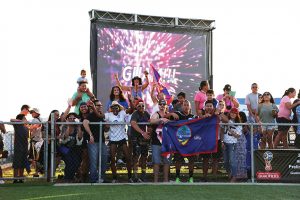
By Marvin Iseke

Iseke
There’s no doubt that world sports, and in particular football, are moneymakers — for the sport itself, top-level athletes, sponsors, partners, and other stakeholders.
The 2018 FIFA World Cup Russia generated over $5.3 billion in revenue, according to the FIFA Web site. Deloitte Sports Business Group’s annual review of football finance found that the top 20 professional football clubs in the English Premier League posted over $8 billion in revenue from the 2019-2020 season.
Three of the world’s top football players — Cristiano Ronaldo, Lionel Messi, and Neymar — feature in the top five of Forbes magazine’s list of Highest Paid Athletes in the World in 2020 as No. 2, No. 3, and No. 4, respectively. The three athletes combined earned more than $304 million in 2020 from endorsements and salaries among other streams of income.
But how does this all translate to countries with less developed football landscapes and the billions of other players and fans around the world?
For the Guam Football Association, one of the smallest member associations of FIFA (the Fédération Internationale de Football Association) which has roughly 5,000 members, the support from FIFA, the Asian Football Confederation, the East Asian Football Federation and local business sponsors create opportunities and opens doors for Guam’s community at large to play and participate in the world’s top sport, or to use the sport as a vehicle for success in other endeavors. Additionally, the allure of popular national teams, successful professional clubs, and players may also fuel dreams in young athletes looking to work up Guam’s elite player pathway.
The Guam Football Association is the official governing body of the sport of football, or soccer — as well as futsal and beach soccer — in Guam. GFA is made up of 13 member clubs in its Congress, a president, two vice presidents, six executive committee members, a general secretary and a staff of about 20 individuals. The organization oversees Guam’s representative teams from the youth level to the senior level, the development of coaches, referees, and administrators, and the management of domestic competitions, leagues, and activities.

As a member of FIFA since 1996, Guam has one vote in the world organization’s elections, equal to that of larger countries like Germany, the United States, and China. Likewise, Guam has one vote in the Asian Football Confederation after gaining full membership in 1992 and the East Asian Football Federation as one of its founding members in 2002.
Guam’s national teams have competed in FIFA World Cup qualification, Olympic Games qualification, AFC Asian Cup qualification, EAFF E-1 Football Championship qualification, and the annual Marianas Cup, among other international tournaments at varying age divisions in both men’s and women’s competitions. Top-level players in Guam compete in the Budweiser Soccer League, the Bud Light Women’s Soccer League, and the Aloha Maid Minetgot Cup Elite Youth Soccer League. Top-level adult players also compete in the annual Bank of Guam GFA Cup and Jamaican Grill Women’s GFA Cup tournaments.
Recreational players participate in the GFA Women’s Recreational League, the Docomo Pacific Soccer Moms League, and the twice-yearly Triple J Auto Group Robbie Webber Youth Soccer League. Hundreds more play in interscholastic leagues. More have played in the Budweiser and Bud Light Futsal and Women’s Futsal Leagues, the Bud Light Co-Ed Masters Soccer League, and the Land Shark Beach Soccer League.
Politically, Guam continues to have representatives on FIFA, AFC, and EAFF committees alongside representatives from the world’s top football countries. Others from Guam have earned various levels of professional and international coaching licenses, FIFA and AFC Match Commissioner designations, and FIFA Assistant Referee badges, among other distinctions, with so much more still to achieve in the coming years.
 Aside from financial support from grants and sponsorship to fund programs and activities, GFA has managed to succeed and thrive over the years from continuously professionalizing its operations. In fact, a prerequisite to obtaining funding and grants from FIFA, AFC, and EAFF is measurable structural development and management in all aspects of the sport — from finance and governance to technical development and media and marketing.
Aside from financial support from grants and sponsorship to fund programs and activities, GFA has managed to succeed and thrive over the years from continuously professionalizing its operations. In fact, a prerequisite to obtaining funding and grants from FIFA, AFC, and EAFF is measurable structural development and management in all aspects of the sport — from finance and governance to technical development and media and marketing.
Operations are constantly audited. Results are weighed against proposed outcomes from planned budgets. Success is measured by different variables — growth in sporting participation, visibility in the community and internationally, revenue generation, achieving milestones, and winning international awards, among others. Longevity depends largely on the consistency of success, and like any other business, it’s not always easy. Perceived success in one area might mean a seemingly irreparable deficit in another area. That which may be best for the group as a whole might come at the expense of a few.
GFA has developed over the years in the direction of shaping a business model that works for the overall benefit of its stakeholders. It’s not the perfect model currently, but an ever-evolving model that relies on its team members identifying trends of all aspects of the sport, on and off the pitch. From an organization built from the passion of volunteers in its earliest years to the organization today that thrives because of the support of FIFA, AFC, EAFF, and local business sponsors and the continued passion of individual team members working toward a common goal, football in Guam continues to move forward and upward. — Marvin “Ike” Iseke is the General Secretary of Guam Football Association. He can be reached at [email protected]. Guam Business Magazine is a media partner of GFA.
















